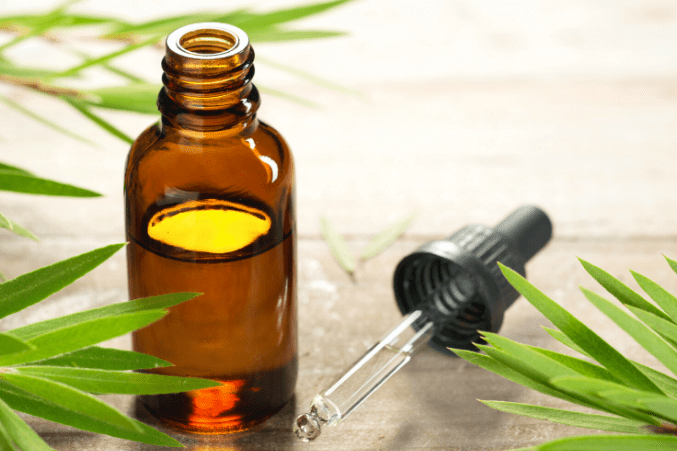Let’s talk about tea tree oil for acne!
You must have heard that ‘skin conditions like acne are only skin-deep’.
However, only someone who has struggled with acne would know that it can affect more than your skin!
You could do anything just to experience what it feels like to have clear, healthy skin every morning.
Sure, you’re all up for ‘acne positivity’ and ‘self-love’ but deep down inside, you may want to get rid of your acne. It’s natural to look for treatment options.
While there are a plethora of over-the-counter medications and skincare products available in the market that claim to treat and prevent acne, they are often infused with harmful chemicals and agents that only damage your skin in the long run.
After being betrayed by expensive creams and serums, you may be desperate to find that one natural product that you can shout praises of!
Well, this is where tea tree oil comes in as a skin savior!
First Off, What Is Tea Tree Oil?

Tea tree oil is obtained by steaming the Australian tea tree leaves.
This magical oil is said to possess excellent anti-bacterial properties and hence, it serves as a natural antiseptic.
While this essential oil has been used by Australians as a traditional treatment option for centuries, modern-day people have discovered it as a natural remedy for acne.
Benefits Of Using Tea Tree Oil For Acne

While using essential oils for improving the health and appearance of the skin is not a new concept, tea tree oil has gained a lot of popularity among all the available options – and for good reasons.
You may be surprised to hear that tea tree oil can work just as effectively as benzoyl peroxide when it comes to treating acne. And minus the harmful chemical side effects, of course!
This essential oil has a herbal scent that comes from a blend of over 100 medicinal compounds.
Many of these compounds are believed to have a calming effect on the skin and hence, they improve the appearance of acne.
Research suggests that applying a 5% concentration of this essential oil on a daily basis can treat pustules and papules; the two types of pimples common to acne-prone skin.
A 2006 study confirmed that tea tree oil is packed with powerful anti-inflammatory and anti-microbial agents and that it may help in treating pimples and acne lesions.
Moreover, a study conducted in 2016 revealed that participants who applied a mixture of tea tree oil and resveratrol experienced less oily and clean skin.
Not only this, the pores on their skin also grew smaller. Researchers concluded that using tea tree oil could potentially improve skin conditions for people struggling with acne.
Another study on tea tree oil involved participants applying the oil twice a day for around 12 weeks.
The results implied that tea tree oil could help in improving moderate acne conditions without causing any side effects.
How To Use Tea Tree Oil For Acne

If you use tea tree oil with a very strong concentration directly on your skin, it may result in a sensitized reaction and trigger irritation, redness, or swelling.
Out of the 100+ compounds found in this essential oil are some fragrance ingredients, such as linalool and limonene, which may cause skin reactions.
Therefore, diluting tea tree oil before use is a must. For safe and effective dilution, simply add one or two drops of the oil into 12 drops of carrier oil.
As with any other topical treatment, you should first do a patch test with tea tree oil to ensure that it is safe to use it on your skin.
Apply a little quantity of the diluted oil on your elbow and look out for any allergic reactions or skin sensitivity signs.
Once you’re satisfied, here’s how you can use tea tree oil for acne.
- First things first, use a gentle cleanser that works for acne-prone skin to wash your face.
- Apply an anti-acne solution that has at least 2% salicylic acid and leave it on for a few minutes.
- Put a few drops of tea tree oil on a damp cotton bud and dab it on the affected area of your skin. Target the blemishes directly.
- Follow up with a moisturizer that suits your skin.
- Alternatively, you can mix a few drops of tea tree oil with a light moisturizer and massage your face with the mixture.
- Apply a broad-spectrum sunscreen with SPF 30 or greater every morning before you head out of your house.
Consider applying tea tree oil to the affected area on your skin twice a day as a part of your morning and night skincare regime.
Disclaimer: Immediately stop use if you see any signs of irritation, redness, swelling, or itchiness.
Also, never use a benzoyl peroxide product until you’re sure that your skin reacts well to the tea tree oil.
The Bottom Line

Tea tree oil is considered a safe and natural treatment method for acne as far as the topical application is concerned.
The key to getting rid of acne and acne scars with this oil is to use the right concentration.
That being said, some users may experience a few temporary and mild side effects, including itching, swelling, redness, dryness, and irritation.
It is best to stop use and consult with a dermatologist in such cases. Please note that people with eczema should NOT use tea tree oil for acne without a doctor’s consultation.

This account is run by a team of writers, researches, and more who simply love contributing to the site.
